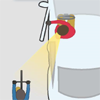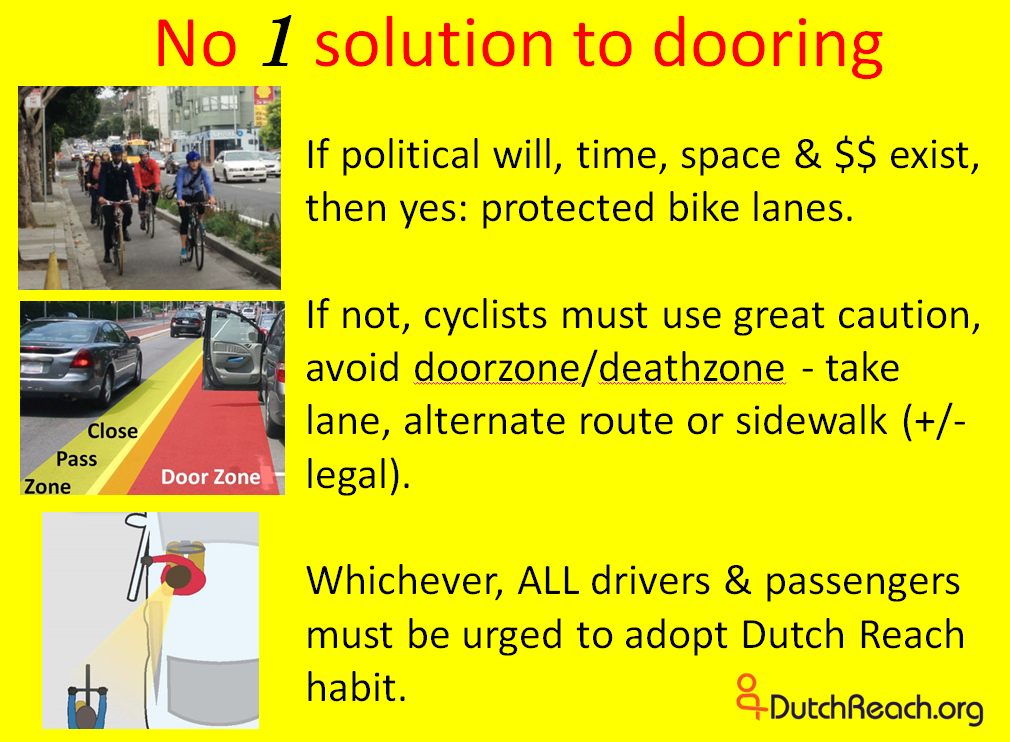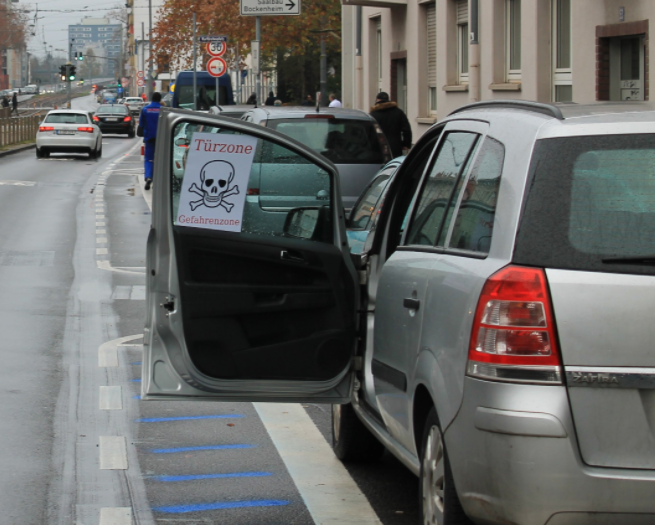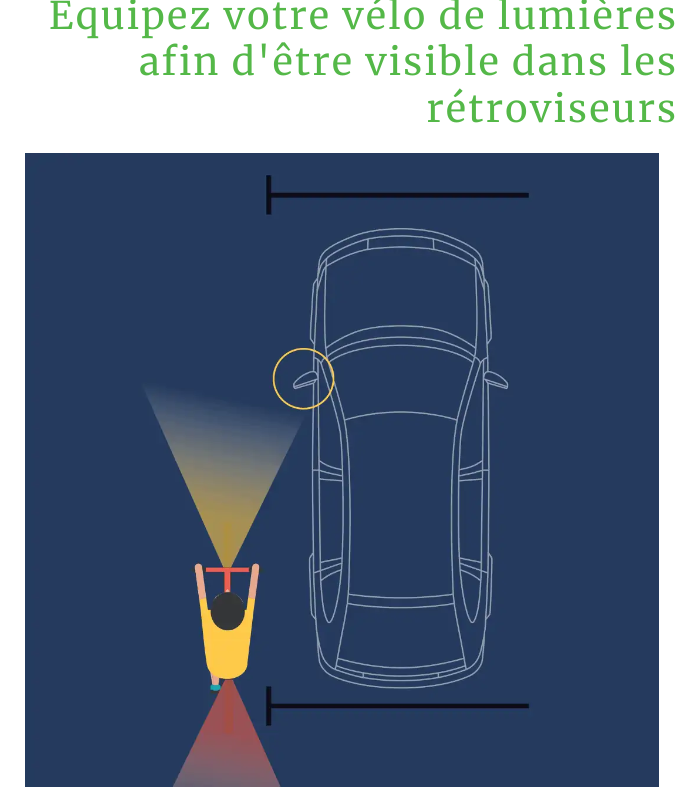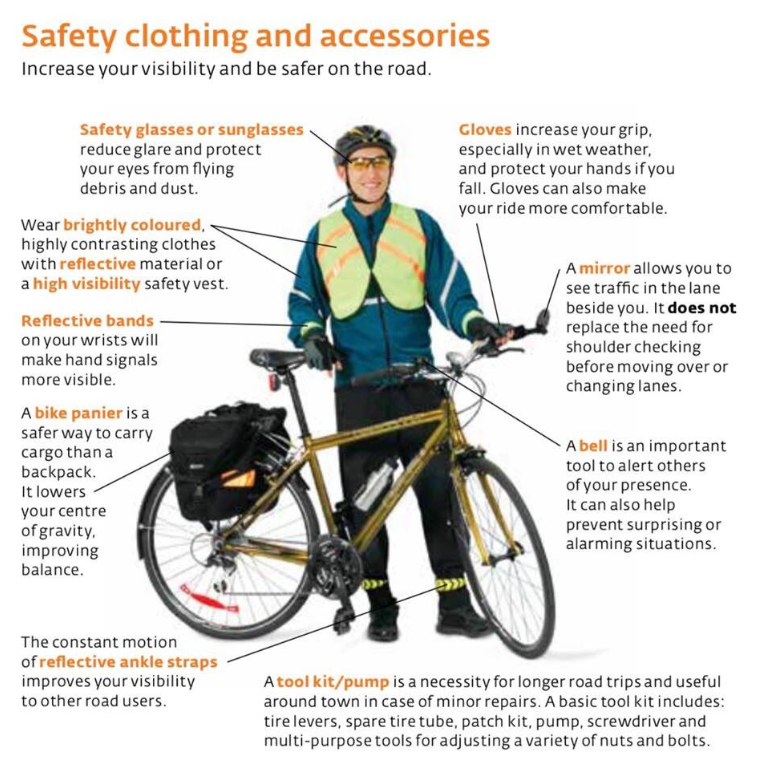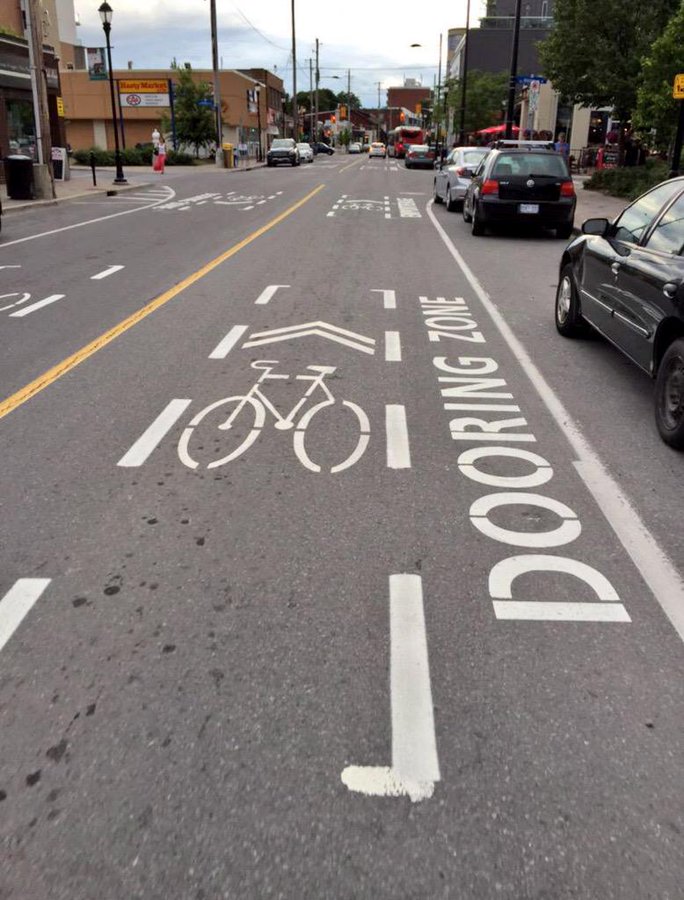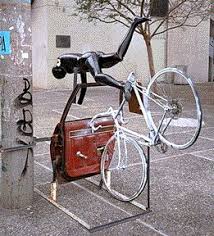Let's be clear...
The Dutch Reach is for drivers & passengers. Not for cyclists.
No one is telling cyclists ever to trust motorists. But to the extent we can get the motoring public to be more cautious, routinely & habitually, we cyclists and other vulnerable road users will more likely get home alive.
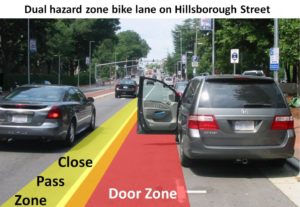
Even the safety of 'safe zones' is relative. Here dual hazards compromise a 'safe zone' -- which would otherwise be the bright yellow stripe.
NOTE!! Keep TIPS of your handlebars out of door zones!
Measure from the tips, not from you eyes or wheels! And door zone width varies with vehicle door lengths, width & position. Don't depend on street markings.
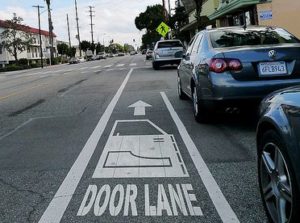
Door Lane / Bike Lane aka Death Zone, Santa Monica, CA, USA.
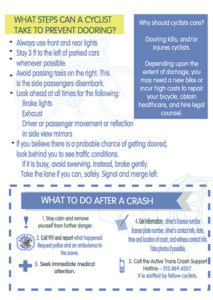
Steps A Cyclist Can Take to Prevent Dooring & After Crash - "Look Chicago" campaign, 2013.
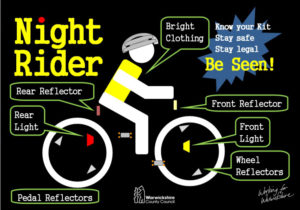
To avoid being doored at night, you must be visible to exiting drivers or passengers. A bright headlight is a must. Poster: Night Rider - Stay Safe, Be Seen, c/o Warwickshire County Council, UK 2012.
Another good summary - with pictures & lists- of dooring prevention advice is How to avoid getting doored, by Better By Bicycle of Melbourne, Australia (where motorists drive on the left).
Avoiding Bike v Car Crashes
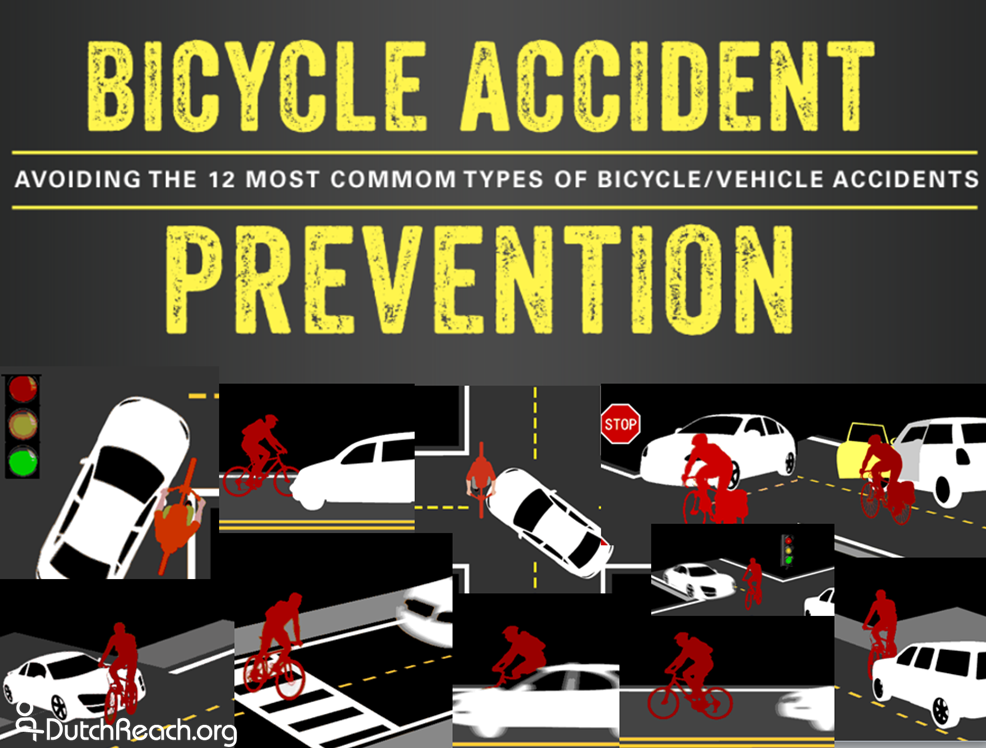
Click here or image to view 12 gif animated road-sharing safety lessons for cyclists & motorists.
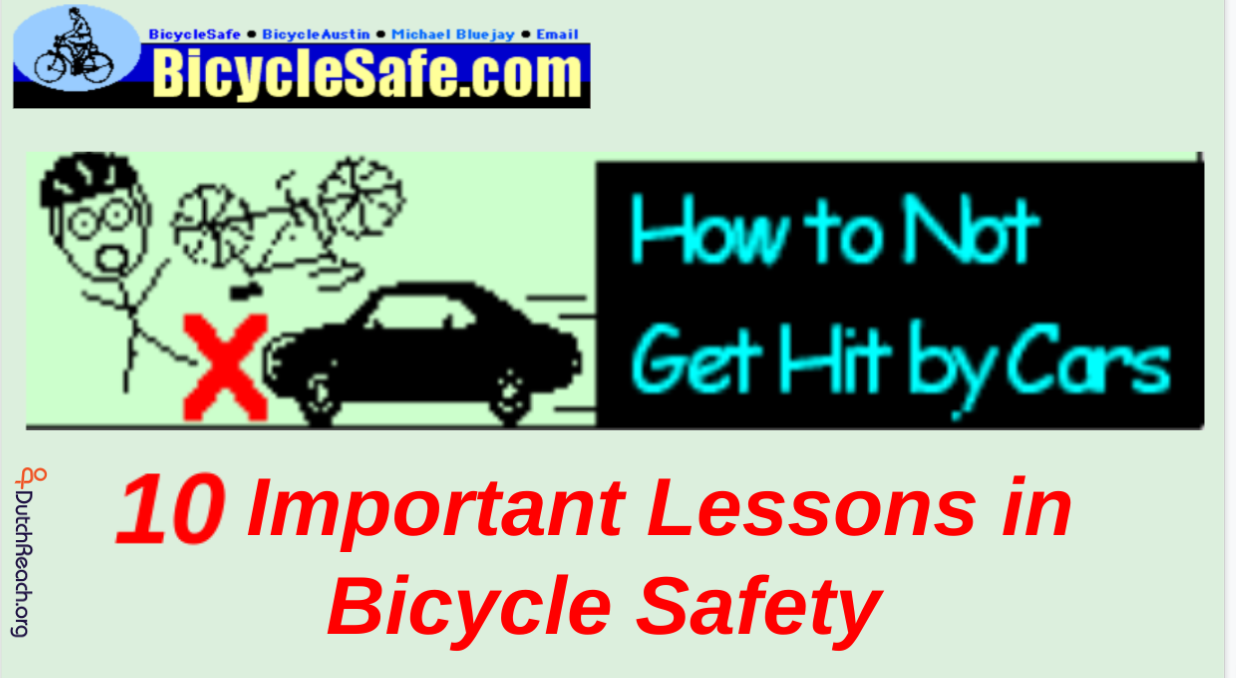
How to Not Get Hit by Cars - Important Lessons for Bicycle Safety, by BicycleSafe.com
Dies ist mein absolut größter Alptraum und Städte wie @Koeln bauen noch immer Infrastruktur welche diese Art von Unfällen einplant 🤬 pic.twitter.com/FLXLQsPha5
— Peter Ullrich (@PJUllrich) October 23, 2020
Broken Shoulder by Dooring
@tongscott @tongscott Here is what happened when my shoulder met an open car door and then the pavement. Bicycle at speed was not even involved. just tripped. Hope you are well soon pic.twitter.com/Mv4RKrRG27
— Www (@Www56250827) November 2, 2022
HOW TO NOT GET DOORED* - TIPS re: DOORING AVOIDANCE FOR BICYCLISTS
Note: While working for safer streets and drivers, cyclists must still do everything we can to avoid getting doored. My summed advice --which is a bit of a treatise -- follows immediately below. But for wisdom from more established authorities see: Tips to avoid being doored c/o Bicycling Western Australia. Also recommended are VicRoads' short list and San Francisco Bike Coalitions safety tips on dooring, far down below but worth the trip!
Dooring Defense for Urban Bicyclists
Aside from extraordinary luck, there's no flawless formula for an urban cyclist to avoid getting doored. "Never ride in the door zone" is excellent advice -- but sterling as it is, it's difficult to always follow. Illegally parked or stopped cars or pedestrians block the bike lane, passengers stuck in traffic threaten exits from the left, fast traffic, road hogging SUVs, trucks, vans and buses, potholes, trash or whatever may crowd you close or into the door/death zone. Which risks to take, which not, is a ceaseless gamble. But we can develop better practices, skills, reflexes and judgment to improve our odds.
Here are five questions to consider.
1) Where is it safer to ride?
2) How can I reduce risk when in bike/door lanes?
3) What can I do before I start pedaling?
4) How can we curb heedless doorings pro-actively?
5) What should we do if doored?
1) Where is it safe to ride?
Bike in the 'safe zone' (see diagram at left) -- relative to any vehicle's open door width -- that is, about 3 to 4 feet from stopped or parked vehicles on either side. Vehicles passing cyclists should also allow at least 3 feet clearance as well. Illegal though it be, heedless passengers also fling open doors and exit into the erstwhile "safe zone" or bike lane. Nonetheless, the 'safe zone' is generally your best bet. Make it your habitual practice so you gravitate there even when your attention (unfortunately but inevitably) lags. Often the safe zone coincides with the left line of a "bike lane", but is no longer a "safe zone" as the "door/death zone" is now intruding because of double parked, partially parked or stopped vehicles, still-open doors, standing pedestrians, truck deliveries or buses blocking the corridor.
Avoid the Door Zone aka ‘Death Zone.’ Within the width of any fully opened door is the Door Zone. Once fully extended, or hit edge on, a door is a pop-out wall. Nick it or be nicked, hit it with handlebars, front wheel or pedal and the contact, veering, loss of control or crash can be fatal due to direct impact, being thrown over the door, into a pole, tree, another vehicle or onto the street. A hit to the handlebar will likely cause loss of control, a crash with rider strewn into the path or under the wheels of on-coming traffic. Dodge a flung door and you may also lose control, fall and crash. Your swerve may put you into direct danger from oncoming traffic or cause you to lose control and crash as well.
Always be vigilant with hands hovering on brake levers -- at the ready to slow or stop.
Never trust a bike lane, sharrow, unmarked or unprotected corridor, especially if intruded by door zones, ie. if within 3-4 feet of parallel parked cars to one side or by stop-&-go traffic on the other. Proper sharrows -- shared lane arrows -- should be placed well outside of the door zone and should indicate to drivers as well as cyclists that cyclists are welcome and expected to ride in this section of road within the travel lane. Ride the sharrow arrow only when it is properly placed to stay clear of doors.
Absent 3 or 4 feet of continuous clearance from adjacent stopped or parked vehicles on either side, use acute caution: slow down, stop, claim the lane, retreat and proceed when and where it is safe, by claiming the lane, or using the sidewalk or another route to advance more safely.
2) How can I reduce risk when I opt or am edged into door zones?
When the 'safe zone' itself becomes unsafe, you have several options based on circumstance and judgment: a) Take the lane, b) Pull over and wait for safer passage past the obstruction or narrowing due to traffic, bulky vehicles etc., c) Take to the sidewalk if available, and preferably legal, but be respectful of pedestrians, careful and cautious as sidewalks are fraught with their own risks -- driveways, opening store doors, irregular surface, intruding bushes, posts etc. You may be best advised to walk your bike on the sidewalk. d) Switch to a safer though perhaps less convenient or direct route.
Learn to "Take the lane" - safely - to stay out of dooring range when narrow crowded roads would otherwise push you to the side. Safely means do a 'shoulder check' or mirror check before taking the lane for yourself -- which is your legal right and can be much safer than taking just a little more such that drivers might still consider passing you. For if they do they could then force you back over should the road become narrow or oncoming traffic cause the driver to veer into you, squeeze your into the door lane, or cut you off. So take the whole lane to assure safe anti-dooring distance, but shoulder check for oncoming traffic from behind before you do. Avoid swerves out into traffic so take the lane carefully and gradually. Or stop in safe place until on-comings pass, or use sidewalk.
Tip re: Shoulder checks. You get an easier, fuller head twist & view back over your shoulder if you dip your head down as you turn neck and head to look back!
Never speed within door zones, and never speed down hemmed in, door-zoned corridors. The less side-to-side (car-to-car) safe space you have (in Britain it's called "filtering") the slower you should go. You can’t reliably check all vehicles left and right. You may not stop soon enough if ambushed. You can’t safely swerve very far in either direction. Slower is generally safer as direct collision force is lessened; but if knocked into traffic, not. Speed exponentially ups the collision force with which you hit the immovable door, or if knocked or hurled out into traffic or up and over the door -- may result in alternative violent impact or impaling as well as greater road kill risk.
But note: Even if going slowly at the outer edge of a door zone/bike lane, a knocked handlebar or a reflexive swerve could cost your dearly - causing loss of control, sending you into fast and dangerous oncoming traffic, or into the path or under the wheels of a slow moving truck or bus in the travel lane. Trucks, vans and SUVs can have very wide doors - and along with far-from-curb poorly parked cars -- the actual door zone is of variable width.
Scan for signs of life, ie. occupied vehicles. Check windows for drivers and passengers in stopped/parked cars ahead, and ANY signs of activity such as brake lights just gone off, cabin lights, tail lights, cell phone screens, turning wheels, cars just recently parked, or unusually stopped or incompletely parked vehicles. Glimpse side view mirrors as a driver may be visible.
Look & listen for door opening. Be vigilant of every marked taxi, black livery'd sedans, delivery and tradesmen vans, public works trucks, and any abnormal slowing and stopping which is typical of Ubers or Lyfts, unmarked limo livery, especially in drop off destinations of greater risk. And beware the deadly Uber/Lyft Effect of flung open doors as passengers bail from the travel lane into your corridor!
Be extra cautious in all areas serving commerce, retail stores and office buildings, fast food joints, restaurants and entertainment. Also, be wary in school zones and near churches on Sundays, etc. Dooring risk on main routes and in dense districts fluctuates with day and time, worse when traffic and parking turnover is high: a.m. & p.m. commutes, night life action with instant drop-offs, periods of caffeine deficit and alcohol excess hours, etc..
Look out also for pedestrians and car owners* stepping out between parked cars, or with back to you in or entering door zone/bike lane possibly about to open door or otherwise cross or obstruct your right of way.
* The proper and safest way for motorists to approach and enter their vehicles is from around the front - the hood end, thus facing on-coming traffic, and NOT to approach from the car rear. Likewise, upon getting out, drivers and passengers should exit and walk around to the back of the vehicle to reach the sidewalk, again facing and watching for on-coming traffic.
YELL! Your shout is your horn! - & your first & fastest defense as you also brake to slow. A sharp loud shout can abort a driver's exit if heard soon enough. (Though if a door's been flung it's unlikely to be retrieved in time). So grab your voice and use it! It can save your skin many times over.
Scream out: Hey!!! Watch OUT!!! or Watch it! Door!, Don't!, No!, Shut It! or whatever you can exclaim fast, loud, to command the door-er to stop or retreat. I like 'Hey' & 'Watch it' as they come out on your first burst of expelled lung power! And these are general purpose shouts. Let offenders know they are blocking or about to block your path. Yell at first sight of a potential dooring or endangerment.
Practice YELLING in other situations as well so you won't be inhibited or hesitate when you need it most. Don't be embarrassed. Shouting is an all purpose exceptionally powerful way to protect yourself from careless, inattentive drivers and pedestrians who might well not have noticed you or cared otherwise. Other favorites but less urgent: Coming through! On your right/left!
Bells & horns? Not so much. They are quieter, less likely to be heard amid traffic, or heeded. They are slow to be sounded, are ambiguous, and may lack 'edge' or urgent alarm. Not so a loud, pitched scream!!! You need your fingers or hand on your brakes levers or handlebars to slow and control your course, not busy with the horn or bell. Sometimes they don't function right and you have to try again. The further ahead the risk, the less likely it will be heard and precious time is lost. You can yell, brake and steer at the same time.
Maintain a steady, predictable course in the safe zone: Do not weave in and out of open parking spaces as you are less likely to be seen either by on-coming traffic behind nor by drivers or passengers preparing to exit from vehicles ahead. Similarly, use extra caution when turning onto a street with parked cars. Clear the first vehicle's door zone as you merge into the safe zone - the door could be already open, your line of sight - or the drivers -- blocked or obscured and you come around unexpectedly.
Keep vigilant. Avoid day dreaming or distracted thinking. Don’t bike when tired. No ear buds. No cell phones or app actions. No improperly secured bags or baggage. No coffee cup in hand!
Keep hands on brakes, and know how to brake quickly yet safely without losing control: 3 to 1 pressure ratio on front to back wheel brakes to reduce risk of skidding out.
Be aware of on-coming traffic from behind. Use a mirror on helmet or handlebars. Know how to do an quick "shoulder check." These help you judge when its safe to 'take the lane' to get out of the door zone or swerve to evade the door more safely.
Don't get squeezed - Ever! by Chester Kojro. Here is a very important column about bicycling safety, regarding the seriously under-appreciated hazard of getting pushed or crushed by passing traffic, especially when cycling alongside large, long truck rigs -- the 'Takes Wide Turns" types are worst -- as can squeeze adjacent cyclists or devour us under their unexpected (but inevitable) in-swaying rear train as they take a hooking curve or turn. Getting squeezed by any passing traffic can force you into the door/death zone, off the road or under the rig and wheels. Take time to read this. His basic take home to get home: take the lane.
3) What can I do before I start pedaling?
Be Highly Visible!~ A bright front light is absolutely necessary to give notice at night - and also advantageous by day. Wear safety vest with reflective strips, add reflectors and reflector/dayglo tape to bike, backpack, etc. Use bright blinking head lights beside parked and stop & go traffic. Wear neon/dayglow jackets, shirts even during the day. White shirts, socks and sneakers, day-glow helmet colors & back-packs with reflective tape are are a big plus. Ankle lights and ankle-strap reflector bands show human pedal motion. which research shows is more dependably noticed by drivers from afar and 'say' "bicyclist"! Most drivers who bother to check (only 65% do) before opening use their side-view mirror. You will be much more readily noticed in that mirror by day, and perhaps only at night if you have a bright headlight.
Of course, if you actually are Darth Vader or prepping yourself for the mortician, go for it. Otherwise lose the Ninja/bat gear. Juries, if not police, EMS techs and journalists lose sympathy for camouflaged cyclists even if you had the right of way when struck. The first excuse given by many criminally negligent drivers is "I didn't see you." Don't give them grounds.
Wear your (bright) helmet - always. It should be snug, level, & stable. It must stay put despite defy violent shakes or impact. Strap it firmly on. A loose helmet which slides about your head will expose your head to greater risk and less protection when whipped by an impact. Your brain is worth infinitely more than a helmet's price or inconvenience - and ignore the denialists because helmets DO significantly protect..
Wear gloves - as they can spare your hands from scrapes if you fall.
Exercise standard best safety practices. Don’t bike when fatigued, angry, distracted, overly emotional, nor use or fiddle with devices. Keep hydrated to maintain good physical and mental function.
Be wisely afraid, alert for cues of danger, keyed to up your safety skills.
Know the physics & forensics of doorings: Direct collision; thrown over door; into the window; crushed hands; right handle bar snagged, snapped back, throws you out into or under traffic in the travel lane, into poles, trees, obstacles curbside.
Even if just the end of your handlebar strikes or is struck by the edge of a door you will likely lose steering control, crash, fall or be thrown, injured or strewn into further danger. Be advised: wide straight, antlered or curved handlebars present a greater danger than narrower drop handlebars as they allow less clearance. But you see better when seated more upright though.
Drop-handlebars have their own trade offs. These include a lower center of gravity and less wind resistance, more strained or limited lines of sight over vehicle tops and overall. Shoulder checks are more difficult or limited from a forward crouched position. City bikes are bulky, heavy, sturdier, slower, with upright seating the better to see, with wider, heavier tires less vulnerable to potholes, glass, debris, ruts & cracks, and have more road-tire contact for braking.
Choose a safer route. If you can seek out safer routes with separated bike track or paths, or routes you believe are safer overall.
Develop your skills, knowledge and ability: Self improvement resources are available on the web, including; LABiking "Survival Skills", & John S. Allen's Bicycling Street Smarts (free online) or his new Cycling Savvy edition @$5, which teach bike safety knowledge and necessary fitness. Bicycle skills training, classes & videos are also available and worthwhile. Check out the League of American Bicyclists' Smart Cycling webpage and its nation-wide Licensed Cycling Instructors listings for courses, or Cycling Savvy's offerings. Also, Commute Orlando has a fine website offering of bike safety tips & animations whose teachings evolved into the CyclingSavvy program of the American Bicycling Education Association. Outside the US, contact your local or national bicycling advocacy organization.
You may also study bike/driver safety videos such as this from the League of Illinois Bicyclists' Motorist/Driver's Ed Video on You Tube: Share the Road, Same Rules, Same Rights with cycling pro Robbie Ventura.
Maintain your bike, gear and equipment. Acquire and use safety vests, lights, mirrors, helmet, gloves, bell, and keep your brakes adjusted and brake pads regularly replaced.
4) How can we curb heedless doorings
Lots of E's but not easy. A work in progress:
Engineering (infrastructure).
Education (of new & retraining of current drivers, cyclists, pedestrians);
Equipment (vehicle devices, biking safety gear, maintenance);
Enforcement (full, fair, danger focused, forceful fines);
Evaluation (with corrective feedback);
Encouragement.
Engagement (public, private, civic).
5) What to do if doored?
Accept help. Get help. You likely will not be thinking clearly even though you might think you are. Learn what to do as after any cycling / traffic crash. Consult experts & authoritative sites. Don't compromise your rights or recourse.
See the "Doored" Checklist" by Transportation Alternatives Magazine of & for NYC (1998) -- which needs updating and adaptation for your state and local jurisdiction, but is otherwise still an excellent guide.
http://www.transalt.org/files/news/magazine/981JanFeb/checklist.html
Geeklaw references this list:
10 Things to do After a Bicycle Accident [sic - crash]:
Wait for the Police to Arrive
Never Negotiate with the Motorist
Obtain Driver Information
Obtain Witness Contact Information
Document What Happened
Make Sure the Police Take Your Report
Seek Immediate Medical Attention and Document Your Injuries
Preserve Evidence
Never Negotiate with Insurance Companies
Seek Advice from a Professional
Your state or local bicycle coalition usually posts instructions and advice on their websites. Laws and recourse will differ by jurisdiction. But general advice usually holds.
* Why this section in a website on driver behavior change?
As many drivers and passengers fail to use best cautionary practices when exiting their vehicles, the burden of suffering, the onus for avoidance, and the work for prevention will continue to fall elsewhere. 'Dutch Reach' grooming of the young and retraining of adult drivers is primary prevention at the acutest, most immediate point of action. Infrastructure improvements, tighter regulations, enforcement penalties and civil litigation, as well as broad road sharing and vigilance education campaigns all contribute to prevention.
But it is the individual rider who bears the risk of life-altering and fatal doored crashes. Until all other measures prevail -- including the Dutch Reach -- and dramatically reduce this risk, we must do all we can while biking to avoid getting doored - never trusting drivers or passengers see us or act safely. Hence this section on dooring self-defense.
How to Avoid Getting Doored Video
"In car-centric cities, cyclists should never assume that bicycle markings on roads are an indicator of where it is safest to ride. Instead you should educate yourself as to the hazards of many common types of unsafe markings such as "door zone bike lanes" (DZBL)."
-- How to avoid getting doored, Better By Bicycle
Video: "Rule One: Never ride in the door zone. Rule Two: There is no Rule Two." - Joshua Zisson, & Northeastern University.
“…pick your way forward slowly with your hands on the brake levers. Remember, any car door could open!” - John S. Allen, bikexprt.com, Bicycling Street Smarts
Necessity to Avoid Door Zone - Video + Post
Dooring Analysis Video & Commentary, c/o Commute Orlando
September 25, 2011
Where to Bike to Avoid Dooring
Extra-wide Doors
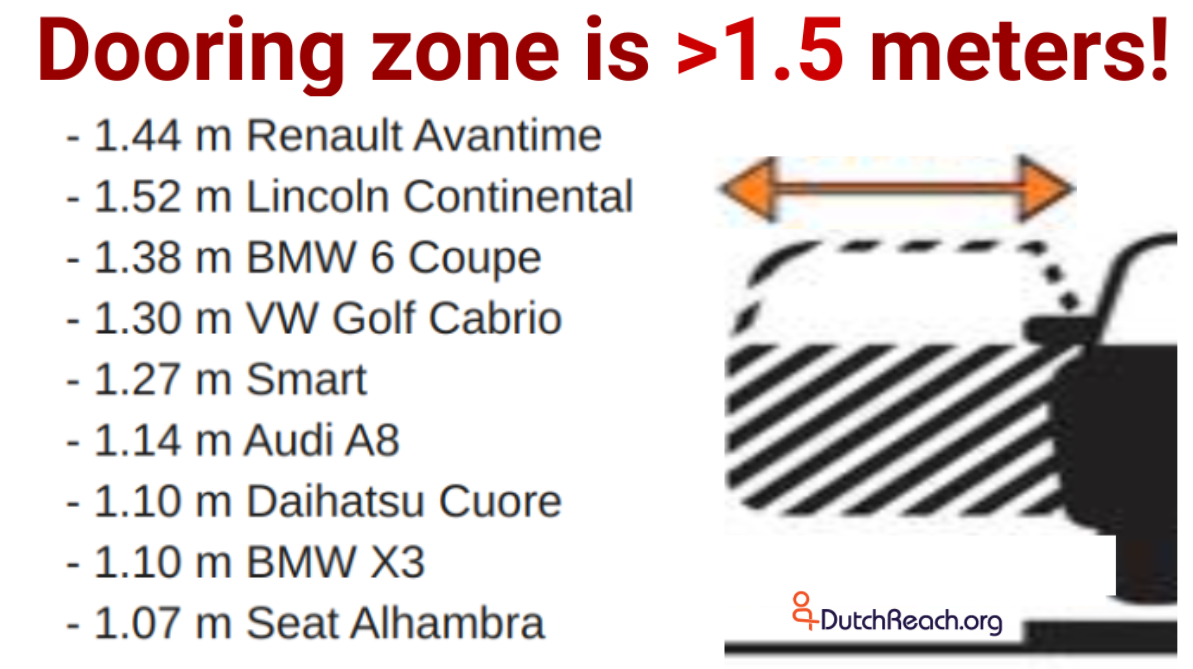
Many vehicle doors exceed 1 meter/1 yard in width. SUVs, trucks, pickups & luxury vehicles pose greater risk. Current bike lane door zones & buffer zones are insufficient for cyclist safety. Chart source here.
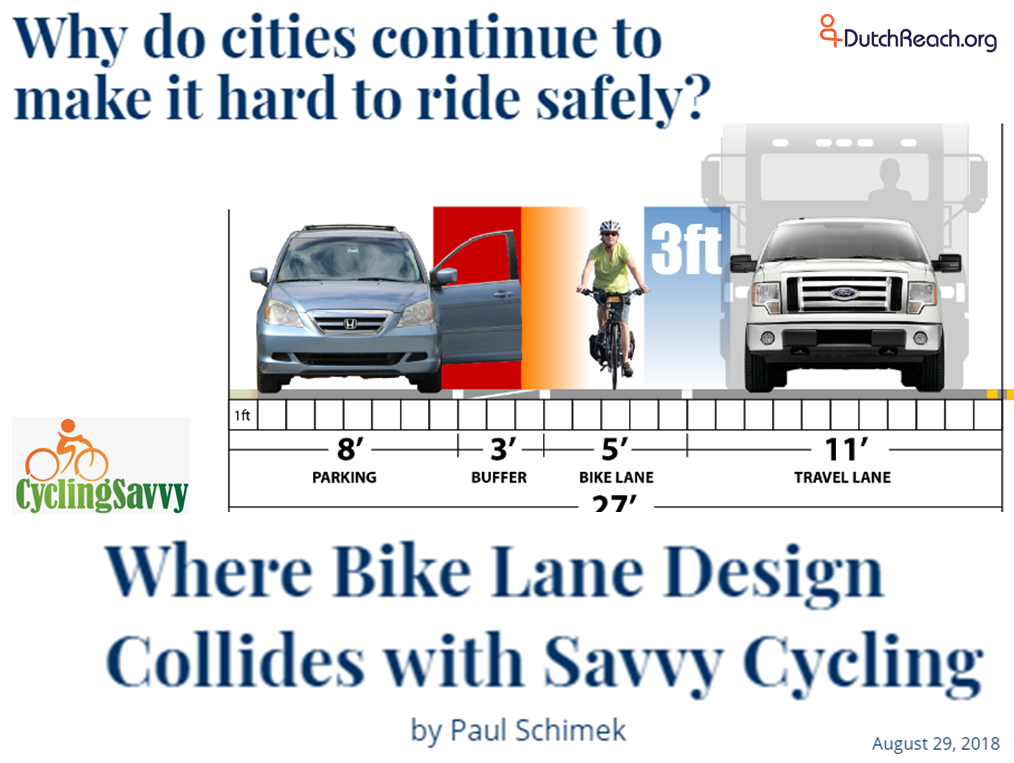
See also: Where Bike Lane Design Collides with SavvyCycling, by Paul Schimek, Savvy Cycling, 29 Aug 2018.
Note re: Taking the Lane. One school of bike safety instructs cyclists to ALWAYS take control of the lane, as door zones are but one of several situations in which "edge riding" puts cyclists at considerable risk. See: Road Cycling: Why Do You Ride Like That? by CyclingSavvy.
Bike Light!
How Not to Get Hit by a Car
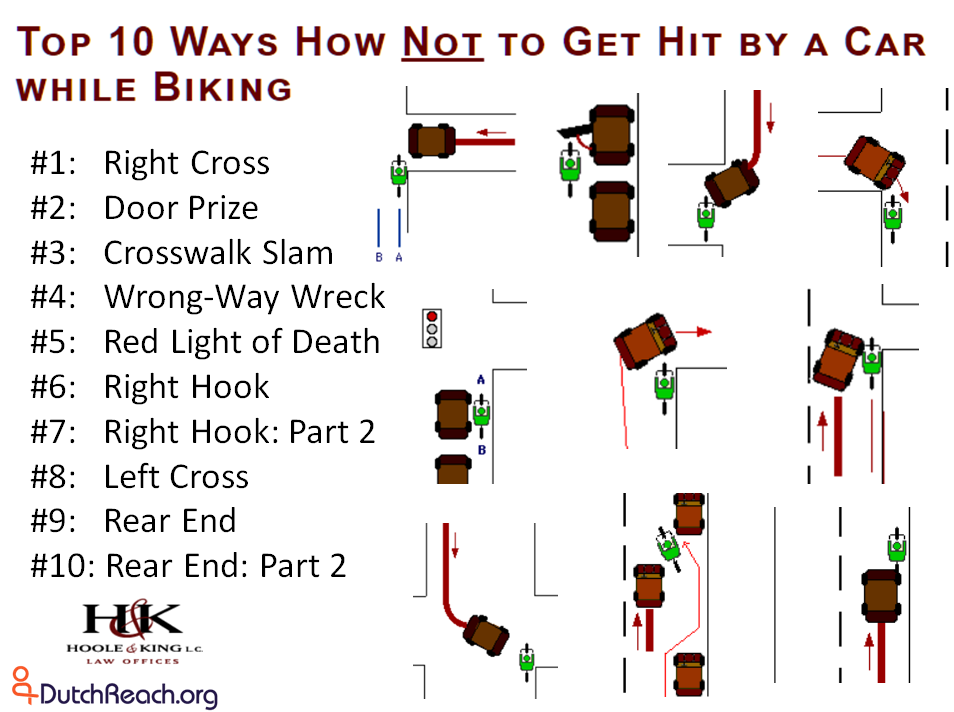
Top 10 Ways How Not to Get Hit by a Car while Biking, Courtesy of Hoole & King Law Offices. Click here or image to view article.
Quizes to Learn By!
 Kids Bike Quiz here.
Kids Bike Quiz here.
"In car-centric cities, cyclists should never assume that bicycle markings on roads are an indicator of where it is safest to ride. Instead you should educate yourself as to the hazards of many common types of unsafe markings such as "door zone bike lanes" [DZBL]."
-- How to avoid getting doored, Better By Bicycle
DOORING ADVICE FOR BICYCLISTS - VIC-ROADS, AU
Advice for riders
Look out for drivers and passengers getting in and out of parked cars.
Be vigilant when riding alongside parked cars and ride out of the car door zone (if possible and safe to do so). If you are riding on a length of road with a marked bicycle lane, you must ride in the bicycle lane unless it is impracticable to do so. In places where there are a lot of parked cars, slow down. Wear bright coloured clothing and use lights at night or in conditions of low light. Share the road safely.HOW TO NOT GET, & WHAT TO DO IF DOORED -- S.F. BICYCLE COALITION
1 Look out for drivers & passengers getting in and out of parked or stopped cars.
ride out of the car door zone
ride out of the car door zone (if possible and safe to do so).
Speed vs Dooring
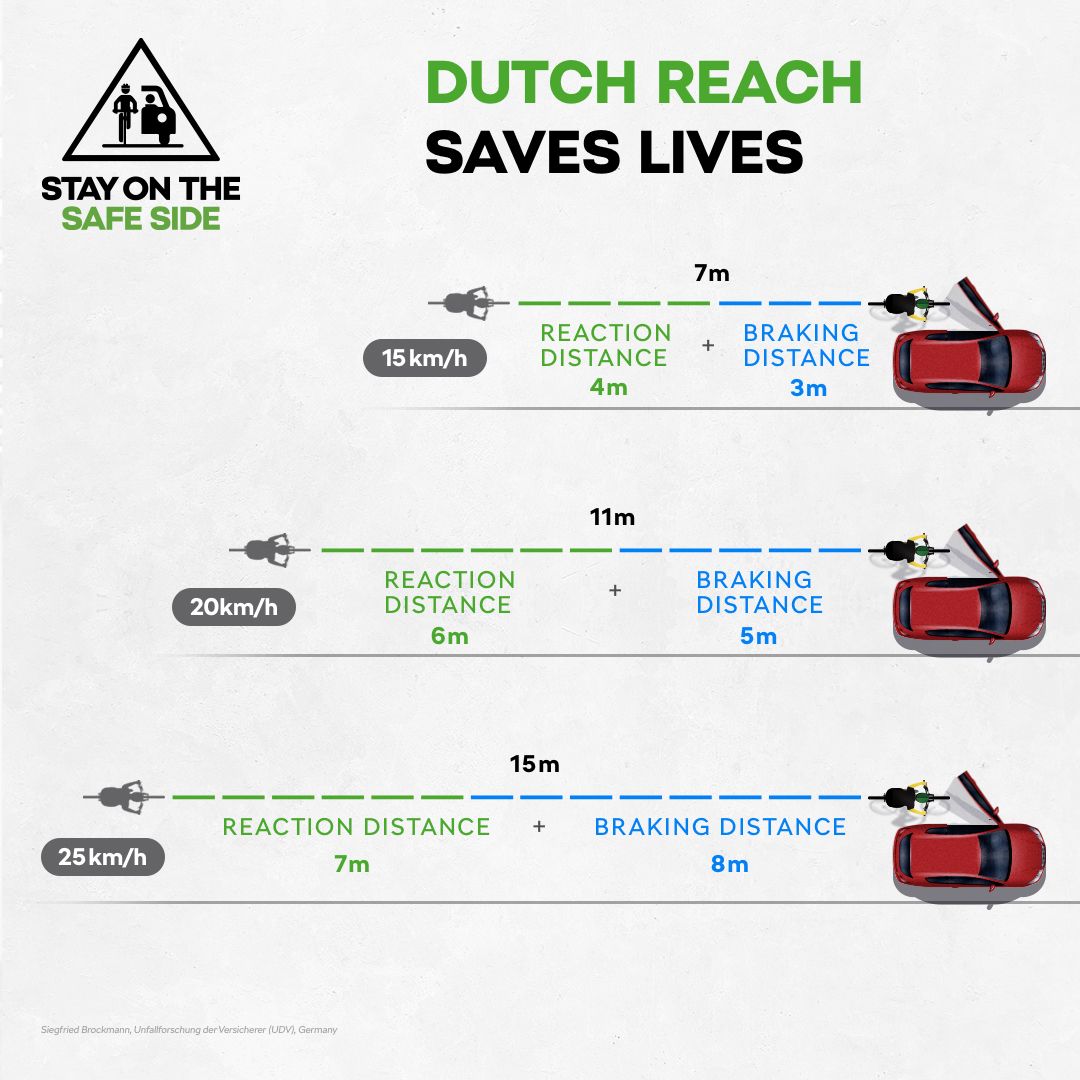
Speed, reaction & braking times vs flung door. Stay on the Safe Side / We Love Cycling campaign infographic by ŠKODA.
slow down where danger lurks
Slow down when passing a lot of parked cars, in car-flanked corridors, whenever in door/death zone.
When cycling fast, never cycle in door/death zone.
BE VERY VISIBLE!
Wear bright colored clothing- such as neon orange, yellow or orange during daylight.
Use bright front and rear lights at night or in conditions of low light, and wear reflective vests or strips.
Moving, shifting, variable & blinking lights and bright lower leg trouser bands -- pants, socks, shoes & pedal reflectors - are most quickly recognized as "cyclist" by the human visual system.
SHARE THE ROAD SAFELY
Share the road safely. Ride predictably. Avoid weaving in and out of empty parking spaces; stay in the door-safe zone whenever possible.
MORE READING:
Don't Get Doored: How to Ride Safely Around Parked Cars
Here's how to avoid one of the most common bike collisions cyclists fall victim to
-- BICYCLING online magazine.
How to avoid getting doored
-- Better By Bicycle
Door Warnings & Advice
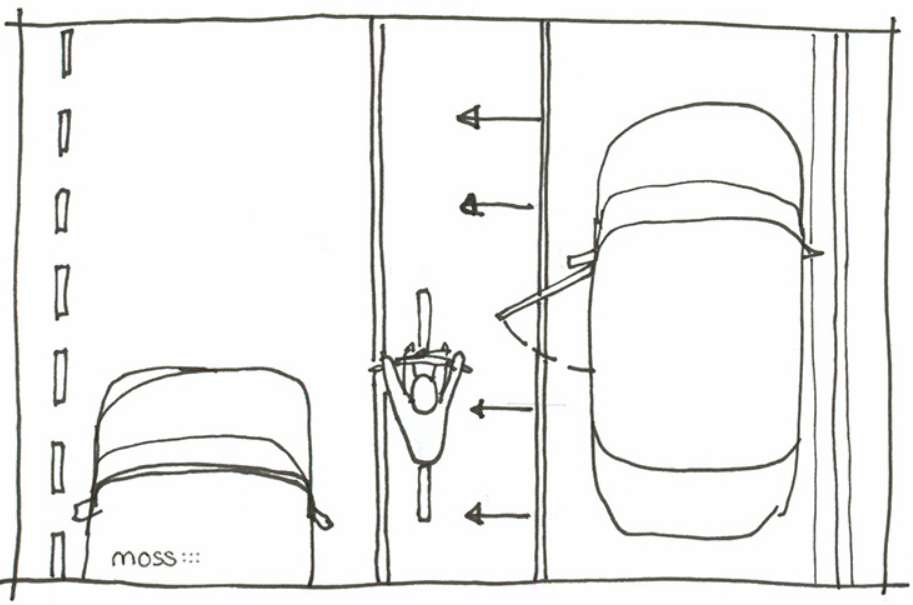
Handlebars must clear the door zone! Watch for signs of life: occupants, lights, just parked, turning front wheel.... Credit: Moss - architecture, Chicago.
BIKING IN CHICAGO: WHAT YOU NEED TO KNOW TO BE SAFE!
June 12, 2014 By: Della Hansmann
Portland, OR, Bike Blog
The Defensive Rider and Dooring
by John Liu, 12 Sept, 2017
BikePortland.org
Most Common Bike-Vehicle Collisions - Safety Advice for Cyclists
Bike-Vehicle collisions constitute about half of all bike crashes. Here's an important summary article with diagrams to challenge your design & messaging skills. It will make you street smarter as well.
 Here's a challenge: Create signs to warn or tip bicyclists on how to avoid one or more of these dangerous situations: Top 10 Ways How Not to Get Hit by a Car while Biking, Courtesy of Hoole & King Law Offices. Click here or image to view article.
Here's a challenge: Create signs to warn or tip bicyclists on how to avoid one or more of these dangerous situations: Top 10 Ways How Not to Get Hit by a Car while Biking, Courtesy of Hoole & King Law Offices. Click here or image to view article.
More Safety Advice for Cyclists -12 Lessons, Animated

Click here or image to view 12 gif animated road-sharing safety lessons for cyclists & motorists.
BIKE DEFENSIVELY - ALWAYS
35% of UK Motorists Negligent Upon Exiting
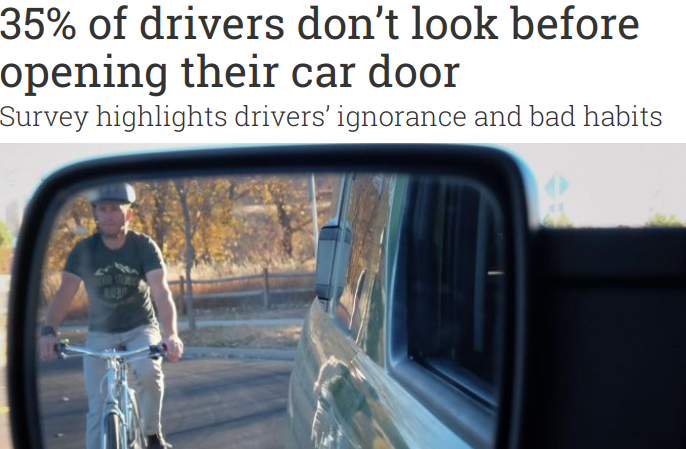
35% of drivers don’t look before opening their car door: A survey by eBikes Direct of 1,000 drivers from across the UK found negligent exiting practices & marked ignorance of cyclists' road rights. Bike Radar, 25 May 2017.
What to Avoid: Dooring Incidents, Conditions, Injuries, Driver Fails
Bicycle Dooring Investigation, Germany, 2015
Researchers examined 225 dooring incidents in Germany
Investigation of bicycle accidents involving collisions with the opening door of parking vehicles and demands for a suitable driver assistance system. M. Jänsch, D. Otte, H. Johannsen, IRC-15-11, IRCOBI Conference 2015, 21 pp.
"The accidents mainly happen because the vehicle occupants are not making sure that the road is clear before opening the door. Visibility problems due to visual obstruction i.e., from bodywork or pillars of thevehicle were not found to be a major factor in these accidents. Thus to avoid these accidents it is sensible to warn the vehicle occupants about approaching cyclists. ..." [From Conclusion, p.20].
Paper also indicates dooring victims' injuries are anatomically comparable to other bicyclists' crash injuries. Helmets appear to reduce head injury compared to non-helmet users, and conflict with pavement accounts for most dooring incident head injuries. About one percent of total reported doorings caused bicyclist fatality.
The researchers conclude that warning assistance devices for vehicle occupants could significantly reduce dooring incidents by overcoming occupant failure to look if the way is clear before opening.
Overview of Dooring & Solutions
Want safer cycling? Don't dismiss dooring*
Marilyn Johnson, The Conversation, May 10, 2012.
* from Australia where one drives on the left!
